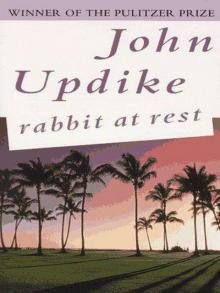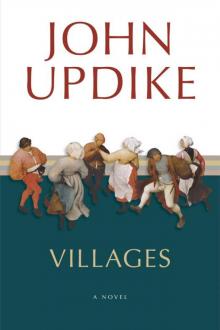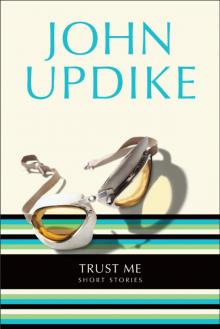- Home
- John Updike
Odd Jobs: Essays and Criticism Page 8
Odd Jobs: Essays and Criticism Read online
Page 8
Nor does his betrothed, the too-perfect May, promise rescue from the ordained environment; a dutiful daughter of privilege, she has “submitted cheerfully to the purple satin and yellow tuftings of the Welland drawing room, to its sham buhl tables and gilt vitrines full of modern Saxe.”
Innumerable other novels could be cited, though Hardy and Wharton are especially lavish, shrewd, and tender, I think, in the building and furnishing of imaginary houses. A fiction can scarcely exist, however surreal and minimal, that does not involve some construction business; Samuel Beckett, the son of a professional quantity surveyor, provides rigorous dimensions for his shadowy hells. Hardy’s Wessex architecture merges into English history, giving his settings a largeness of time as well as space; nostalgia animates Wharton’s specification of the New York she remembered, but also a satiric impulse is at work, and a vivid claustrophobia. Lolita was inspired, Nabokov claimed, by the newspaper story of an ape who, “after months of coaxing by a scientist, produced the first drawing ever charcoaled by an animal: the sketch showed the bars of the poor creature’s cage.” Architecture confines and defines us. Our human world speaks to us, most massively, in its buildings, and a fiction writer cannot make his characters move until he has some imaginative grasp of their environment. Nearly thirty years later I can still feel the thrill of power with which, in my first novel, The Poorhouse Fair, I set characters roaming the corridors of an immense imaginary mansion which I had based upon an institutional building, for the poor and homeless, that had stood at the end of our street in Pennsylvania but that I had never once, as a child, dared enter. Now, as an author, I climbed even to the cupola, and chased a parakeet down long halls, “channels of wood and plaster” where a crossing made “four staring corners sharp as knives.”
In my second novel, Rabbit, Run, an entire street—a steep street of row houses, “covered with composition shingling varying in color from bruise to dung”—had to be constructed to give my young couple housing, and then the fleeing husband had to be followed through the labyrinth of Brewer, based upon a city, Reading, where I had never in fact lived. Truly, the hollowing-out of these habitable burrows, assigning wall tint and texture, visualizing fanlight and doorbell, shag rug and windowsill, constitutes a primary adventure of the fiction-generating mind. (And the fiction-enjoying mind, too: with what delight, in my mystery-novel-consuming days, did I ponder the ominous diagram of the sequestered country house, and the clue-bearing map of the murder-haunted village.) The firmest house in my fiction, probably, is the little thick-walled sandstone farmhouse of The Centaur and Of the Farm; I had lived in that house, and can visualize every floorboard and bit of worn molding. But many houses I have lived in have sheltered little of my fiction, and the various domiciles of the Rabbit books are based upon scanty glimpses, in boyhood, of other people’s mysteriously enviable homes.
Seeing the (unsuccessful) movie of Rabbit, Run, I was struck by how painstakingly the moviemakers had reconstructed the details of, say, Rabbit’s apartment, setting forth for the camera many more furnishings, faithful as to sociology and period, than I had dreamed of. Yet these conscientiously assembled sets were relatively meaningless; they flickered past and could be ignored. They did not pass through, one observed detail at a time, the minds of characters, and become bonded with states of mind and emotion.
The substance of fictional architecture is not bricks and mortar but evanescent consciousness. Sometimes, therefore, a door opens into a hallway impossibly, and the placement of our heating ducts and storage space borders on the irresponsible. I have great trouble, myself, in imagining the floor plans of split-level homes, though I feel they are important sites of the American condition; I spent many words in Rabbit Is Rich in laying out the Murketts’ garrison colonial tract house, which in my hero’s mind environed such intense domestic happiness. With a workman’s simple pride I remember the living-room ceiling that Rabbit covetously observes—the “little sparkles, like mica on a beach, in the overlapping arcs of the rough-plastered ceiling.” Writing American fiction forces us to think about our virtually unthinkable mass architecture, with its murky manufactured substances (Celotex? polyurethane?) and the hodgepodge styles decreed by forgotten developers. The ordinarily ersatz comes to border on the monstrous, as with this California cottage in Nathanael West’s The Day of the Locust:
The house was queer. It had an enormous and very crooked stone chimney, little dormer windows with big hoods and a thatched roof that came down very low on both sides of the front door. This door was of gumwood painted like fumed oak and it hung on enormous hinges. Although made by machine, the hinges had been carefully stamped to appear hand-forged. The same kind of care and skill had been used to make the roof thatching, which was not really straw but heavy fireproof paper colored and ribbed to look like straw.
Less grotesquely, how does one convey the cozy quality of the brick rows of Pennsylvania small towns, with their square porch pillars and tiny terraced front lawns, or discriminate, in New England, among the many subtle styles, much patched and revised, of wooden farmhouse? To describe these houses is halfway to describe the life lived in them. My novel Couples was originally titled Couples and Houses and Days and was all about our entry into other people’s homes, as guests and lovers, and ultimately about one couple’s escape from the “low-ceilinged colonial room whose woodwork was painted the shade of off-white commercially called eggshell” in which they are seen on page one, naked and captive and struggling to be hatched.
The dwelling places of Europe have an air of inheritance, of cumulative possession—hives occupied by generations of bees. In America, the houses seem privately ours, even when we have not built them up, in pine two-by-fours and four-by-eight sheets of plywood, from a poured-cement foundation. Houses are, as Newland Archer sensed, our fate. The residences we build in our fiction need not conform to a floor plan—indeed, the reader’s capacity for visualizing spatial relations is feeble—but they must conform to a life plan, feeding the characters’ senses whenever these turn outward, confirming social place with their walls and accoutrements, echoing in authentic matter the spiritual pattern the author intends to trace. Houses, having been willfully purchased and furnished, tell us more than bodies do, and their description is a foremost resource of the art of fiction. Every novelist becomes, to a degree, an architect—castles in air!—and a novel itself, of course, is a kind of dwelling, whose spaces open and constrict, foster display or concealment, and resonate from room to room.
Can Architecture Be Criticized?
I AM SOMETIMES VISITED by the heretical thought that there is no such thing as good and bad architecture, any more than there is good and bad nature. It is all in where you stand at the time. Victorian domestic architecture, for instance, was thought in the heyday of less-is-more modernism to be simply atrocious: wasteful, decorative, asymmetrical, patchy, heavy, sentimental. But now how oddly charming seem the neo-Gothic, gingerbreaded mansions of, say, Newton, Massachusetts, with their fish-scale shingles, corner towers and bristling gables, long wide porches, busy spindles and brackets, hodgepodge fenestration, and outward air of inward secret passageways and cozy illogic. A lost abundance of materials and richness of household arrangements speaks now in these confident, innocent, ample buildings. Time deposits upon even the satanic mills of Lowell a nostalgic patina.
I live, as it happens, in an area of old North Shore estates, big summer places built, for the most part, by quiet Boston money, though Mr. Frick and Mr. Crane came in from Pittsburgh and Chicago respectively and erected monuments of conspicuous construction. The most modest of the old summer houses encompassed large breezy rooms for the owners and numerous small rooms for the servants; this was sound architecture in an era of cheap domestic labor and for a season when coolness, not heat, was desired. As the upper classes learned to do without live-in servants, and as air-conditioning and modern medicine lessened the terrors of summer in the city, the houses have become all-year residences, hard to heat and aw
kward to maintain, for all their enduring amenities of site and style. Good architecture has become less good, and its most extravagant examples are torn down as uninhabitable (the Frick mansion), converted to public wards (the Crane “castle”), or ignominiously condominiumized.
Row houses, built by developers block by block, were the metropolitan norm in my native Pennsylvania, famously so in Philadelphia but in small towns, too, right to the edge of cornfields. In the postwar period of explosive suburbanization and one-home-to-a-lot tract development, even the most elegant row wore a distasteful aura of compromised privacy and potential squalor. Then, with the rise of fuel and land prices and the return to the inner city, row houses were freshly admired for their efficiency, their close communal witness to the life of the street. They became good architecture.
And what, indeed, of Levittowns? Deplored as ticky-tacky boxes when freshly imposed upon the acres of scraped earth, the uniform units in many areas turned, decade by decade, less tacky and boxlike as proud owners made additions and improvements, and trees and shrubs matured in a pervasive softening. Caring occupancy can redeem unpromising architecture, and impoverished, uncaring occupancy has destroyed many a thoroughly planned and well-intentioned project, in East St. Louis and elsewhere. What we see, in looking at most domestic architecture, is less the spirit of the architect than that of the occupants. The unlovely three-decker, New England’s special contribution to urban design, looks lovely to someone who has had a happy childhood in one, or is moving up to his generous floor-through from a single basement room. The best urban plan, Jane Jacobs and others seem to say, is Topsy’s: let cities just grow, and they will fall into neighborhoods of shops, services, and solicitous mutual awareness. The best plan is the least, the loosest, allowing most scope to human powers of accommodation.
Insofar as we are all architectural critics, we tend to admire either grand gestures (the Pyramids, Salisbury Cathedral, the Seagram’s Building, the Hancock Tower) or else buildings that blend into the landscape. We are fond, exteriorly, of habitations—thatched cottages, pueblos, yurts, igloos—in which we would not care to spend a night. We like buildings that appear to merge with nature, but when the merger involves our sleeping on a dirt floor, or consorting with the rodents that live in the thatch, we opt out. The American psyche is ambivalently pro-wilderness; once we have secured and insulated our own sanitized, electrified Cape Cod ranch, we dislike all further building. Nothing looks uglier than a construction site, with its bulldozer-scarred boulders and tangled stumps and muddy cellar holes where a few days ago green woods sheltered a few frolicking squirrels and raccoons. There is no downward statistic as pleasing as a slump in the number of housing starts.
A healthy hatred of our own species animates, I believe, the most spirited architectural criticism. Faithful readers of The New Yorker have for decades nodded agreement with the witty fulminations of the late Lewis Mumford and now of Brendan Gill against those two inevitable manifestations of a burgeoning metropolis, skyscrapers and expressways. Gill sees nefarious developers conspiring with imbecilic city officials to obliterate the human-scaled charms of the X-rated blocks of 42nd Street, and Mumford saw in Boston’s own Storrow Drive a ruinous sacrifice of riverbank to that vile creature from outer space, the automobile. As if people were not in those automobiles, and had not irrevocably demonstrated their preference for driving over walking.
Are superhighways good or bad architecture? Photographed from above, surely, they have their cloverleafy beauty, though a lot of real clover got paved over. Was Baron Haussmann the creator of the City of Light as we know it, or was he the ruthless razer of vast irreplaceable tracts of medieval Paris? He was both. Is the skyline of New York City any less deserving of romantic rhapsodies than another product of blind upthrust like the Himalaya Mountains? Only if a mud hut is less deserving than an anthill. Is architecture, finally, in the mass (as distinguished from the leaky, inconvenient set pieces of tyrannical maestros like Wright or Le Corbusier), too big, too brute, too tied to money and the popular will, to be judged? I recently saw on television some aerial photographs of a giant futuristic hive of streets and houses in Arizona called Sun City. There it sat, a huge human excrescence sucking water out of the ground and pouring carbon dioxide into the air. It was monstrous. It was beautiful.
Speaking of Wright, is the Guggenheim Museum good or bad architecture? Its shape—a top, in layers, of the ugliest of materials, poured concrete—affronts sedate Fifth Avenue. A spiralling ramp within, it is like no other museum. This singularity can be both admired and deplored. It sticks in the mind; it wakes us up. Within, the viewing space, at a perpetual tilt and open on one side to a man-made abyss, quite fails to give us and the works on display the sense of hushed enclosure, of a casketlike eternal preservation, that the rooms of the Metropolitan Museum and the Frick do. The problems of mounting and lighting weren’t solved in Wright’s design and all the doctoring since has left the paintings still wallflowerish. And yet, we see them twice—once up close, within the limits of the guard wall, and again across the great round atrium, where they take on the intense brightness of miniatures. We slowly spiral along, dazed and amused. Though poor in treasure, the museum attracts tourists. It is a stunt, but why shouldn’t architecture be a stunt? What are Baroque churches but an accretion of stunts? Isn’t one duty of architecture, as of fashion in clothing, simply to be different—to give us a sense of change and renewal in our lives? Showmanship would seem to be part of the architect’s equipment, along with a careless faith that the accomplished work will be viewed from a variety of angles. Architecture does not imitate nature, it adds to it, and, as with nature, the aesthetic effect lies with the beholder. Once a thing exists, especially if it is big, we learn to live with it, and judge it as leniently as we judge ourselves.
Is New York City Inhabitable?
NEW YORK is of course many cities, and an exile does not return to the one he left. I left, in April of 1957, a floor-through apartment on West Thirteenth Street, and return, when I do, to midtown hotels and the Upper East Side apartments of obliging friends. The Village, with its bookstores and framer’s shops, its bricked-in literary memories and lingering bohemian redolence, is off the track of a professional visit—an elevator-propelled whirl in and out of high-rise offices and prix-fixe restaurants. Nevertheless, I feel confident in saying that the disadvantages of New York life which led me to leave have intensified rather than abated, and that the city which Le Corbusier described as a magnificent disaster is less and less magnificent.
Always, as one arrives, there is the old acceleration of the pulse—the mountainous gray skyline glimpsed from the Triboro Bridge, the cheerful games of basketball and handball being played on the recreational asphalt beside the FDR Drive, the startling, steamy, rain-splotched intimacy of the side streets where one’s taxi slows to a crawl, the careless flung beauty of the pedestrians clumped at the street corners. So many faces, costumes, packages, errands! So many preoccupations, hopes, passions, lives in progress! So much human stuff, clustering and streaming with a languid colorful impatience like the pheromone-coded mass maneuvers of bees!
But soon the faces and their individual expressions merge and vanish under a dulling insistent pressure, the thrum and push of congestion. As ever more office buildings are heaped upon the East Fifties—the hugest of them, the slant-topped white Citicorp building, clearly about to fall off its stilts onto your head—and an ever-greater number of impromptu merchants spread their dubiously legal wares on the sidewalks, even pedestrian traffic jams. One is tripped, hassled, detoured. Buskers and beggars cram every available niche. The sidewalks and subway platforms, generously designed in the last century, have been overwhelmed on both the minor and major entrepreneurial scales. The Manhattan grid, that fine old machine for living, now sticks and grinds at every intersection, and the discreet brownstones of the side streets look down upon a clogged nightmare of perpetual reconstruction and insolent double parking. Even a sunny day feels like
a tornado of confusion one is hurrying to get out of, into the sanctum of the hotel room, the office, the friendly apartment. New York is a city with virtually no habitable public space—only private spaces expensively maintained within the general disaster. While popular journalism focuses on the possible collapse of Los Angeles and San Francisco into chasms opened by earthquakes, here on the East Coast, on its oblong of solid granite, the country’s greatest city is sinking into the chasm of itself.
Hardened New Yorkers will sniff, What else is new? Their metropolis has been a kind of vigorous hell since the days of the Five Points and the immigrant-packed Lower East Side. Its vitality and glamour are ironically rooted in merciless skirmish and inconvenient teeming; a leering familiarity with crowdedness and menace is the local badge of citizenship, and the city’s constant moral instruction features just this piquant proximity of rich and poor—the Park Avenue matron deftly dodging the wino on his grate, the high-skirted hooker being solicited from the black-windowed limousine. In a city that rises higher and digs deeper than any other, unchecked ascents and descents rocket side by side, exhilaratingly. In the noonday throng on Fifth Avenue near Forty-second Street, I once saw a nearly naked man, shirtless and barefoot and sooty from his place of subterranean rest, scuttle along in a pair of split overalls that exposed his buttocks, and everyone’s eyes but mine were expertly averted. Mr. Sammler reflects, in Saul Bellow’s late-Sixties novel of Manhattan, “You opened a jeweled door into degradation, from hypercivilized Byzantine luxury straight into the state of nature, the barbarous world of color erupting from beneath.”
My complaint, as an exile who once loved New York and who likes to return a half-dozen times a year, is not that it plays host to extremes of the human condition: there is grandeur in that, and necessity. For the Korean grocer and the Ukrainian taxi-driver, the apparent turmoil holds out opportunity and hope. The chaos is not quite complete; food is trucked in through the tunnels and purveyed in epic daily amounts, Bloomingdale’s brightly peddles kitchen wares to young couples who have somehow found an apartment they can afford, the museums continue to expand, Central Park still offers patches of grass for a sunbath and a doze in the bosom of humanity. But the price of those delights, in the three decades of my exile, has gone from steep to exorbitant. Archibald MacLeish, toward the end of his long life, told me, “New York used to be a giving place, a place that gave more than it took. Now it takes more than it gives.” Even for those with access to the right side of the jewelled door, the city teeters on the edge of dysfunction. Something as simple and, elsewhere, as comfortable as a rainy day tips it over the edge.

 Picked-Up Pieces: Essays
Picked-Up Pieces: Essays Bech: A Book
Bech: A Book Roger's Version: A Novel
Roger's Version: A Novel Seek My Face
Seek My Face The Carpentered Hen
The Carpentered Hen Pigeon Feathers: And Other Stories
Pigeon Feathers: And Other Stories Rabbit Is Rich
Rabbit Is Rich The Afterlife: And Other Stories
The Afterlife: And Other Stories Rabbit at Rest
Rabbit at Rest The Witches of Eastwick
The Witches of Eastwick Gertrude and Claudius
Gertrude and Claudius Bech Is Back
Bech Is Back Hub Fans Bid Kid Adieu: John Updike on Ted Williams
Hub Fans Bid Kid Adieu: John Updike on Ted Williams Marry Me: A Romance
Marry Me: A Romance Museums and Women: And Other Stories
Museums and Women: And Other Stories My Father's Tears and Other Stories
My Father's Tears and Other Stories Collected Poems, 1953-1993
Collected Poems, 1953-1993 Trust Me: Short Stories
Trust Me: Short Stories Odd Jobs: Essays and Criticism
Odd Jobs: Essays and Criticism Rich in Russia
Rich in Russia Higher Gossip: Essays and Criticism
Higher Gossip: Essays and Criticism The Widows of Eastwick
The Widows of Eastwick In the Beauty of the Lilies
In the Beauty of the Lilies Rabbit, Run
Rabbit, Run The Early Stories: 1953-1975
The Early Stories: 1953-1975 Rabbit Redux
Rabbit Redux S.
S. Brazil
Brazil Toward the End of Time
Toward the End of Time The Centaur: A Novel
The Centaur: A Novel Assorted Prose
Assorted Prose Memories of the Ford Administration
Memories of the Ford Administration Terrorist
Terrorist Couples: A Novel
Couples: A Novel Bech at Bay
Bech at Bay The Music School: Short Stories
The Music School: Short Stories Villages
Villages S
S Roger's Version
Roger's Version Pigeon Feathers
Pigeon Feathers Higher Gossip
Higher Gossip Rabbit Redux r-2
Rabbit Redux r-2 Memories of the Ford Administration: A Novel
Memories of the Ford Administration: A Novel The Centaur
The Centaur Marry Me
Marry Me Picked-Up Pieces
Picked-Up Pieces Bech
Bech Rabbit Remembered
Rabbit Remembered Trust Me
Trust Me The Early Stories
The Early Stories Odd Jobs
Odd Jobs The Centaurus
The Centaurus The Afterlife
The Afterlife The Music School
The Music School Museums and Women
Museums and Women Couples
Couples